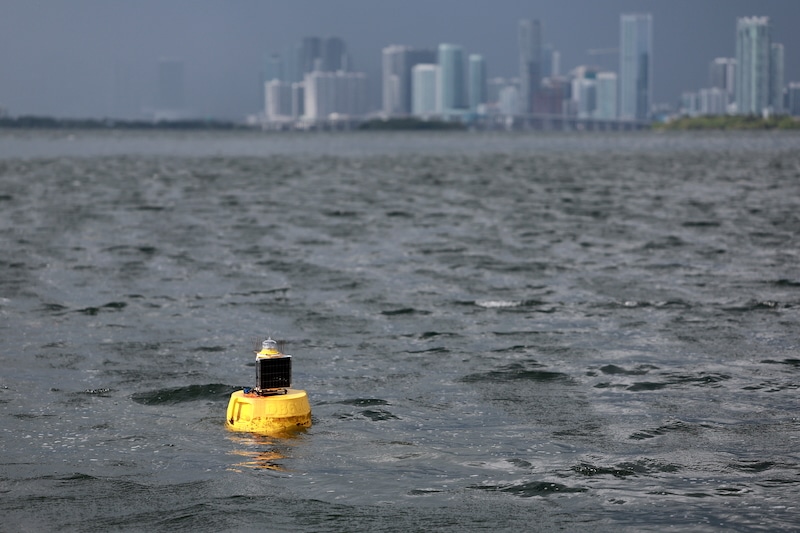This post was originally published on Eco Watch
A new study has found per- and polyfluoroalkyl substances (PFAS) in Miami’s rainwater.
It is the most recent evidence that “forever chemicals” get caught up in the water cycle and circulate over great distances.
“PFAS are practically everywhere,” said Natalia Soares Quinete, author of the study and an assistant professor of chemistry at Florida International University (FIU), in a press release from FIU. “Now we’re able to show the role air masses play in potentially bringing these pollutants to other places where they can impact surface water and groundwater.”
PFAS, widely found in consumer products — from nonstick cookware to cosmetics, clothing, food packaging and firefighting foams — have been associated with health issues in humans and wildlife.
Researchers at FIU spent over a year collecting and analyzing 42 rainwater samples from three sites in Miami-Dade County. They detected 21 PFAS, including PFOS and PFOA — which has since been phased out due to cancer concerns — along with newer forever chemical compounds used in manufacturing.
Several of the PFAS profiles were able to be matched with local sources, while others were not. The researchers said this suggested the planet’s atmosphere is able to transport the toxic chemicals all over, contributing to global pollution.
PFAS are called “forever chemicals” because of their inability to break down easily in the environment, where they accumulate over time. Humans can inhale or ingest them, and exposure to them has been associated with kidney and liver damage, cancer, fertility issues and other serious health problems.
According to the U.S. Environmental Protection Agency (EPA), exposure to low levels of PFAS can be hazardous. The EPA has set limits on some PFAS chemicals in drinking water supplies.
It remains unclear just how PFAS make their way through the environment.
Quinete’s research team is one of the first to extensively survey PFAS prevalence across South Florida.
The team found PFAS concentrations in surface water, including Biscayne Bay, and drinking water. They also detected the toxins in animals who live there, including oysters, lobsters and fish.
Next, they looked to rainwater.
PFAS are able to infiltrate the atmosphere through evaporation or becoming absorbed into microscopic dust and particles. Shifting air currents and wind then buffet them along. When rain forms, its drops fall to the ground, bringing some of the pollutants with them. This cycle happens again and again.
In 74 percent of samples taken from October of 2021 to November of 2022, the most abundant and frequently found PFAS in Miami’s rainwater were PFCAs. PFCAs are commonly used in stain-resistant and nonstick products, firefighting foams and food packaging. High levels of the toxic compounds had previously been detected in nearby surface waters, which indicated that they had come from local sources.
The researchers noticed something else: A shift happened at particular times of year. During the dry season — from October through May — PFAS concentrations suddenly soared, including some normally found in other states such as North Carolina, where facilities that produced goods made with the chemicals were located. This coincided with air masses from the Northeast moving into Miami.
“The season variations were interesting to us,” said Maria Guerra de Navarro, a graduate student who co-led the study, in the press release. “We know there are northern states with manufacturing that matches back to the PFAS we saw, so it’s likely that’s where they are coming from.”
The research team suspected that drier northern currents created ideal conditions for more PFAS-laden particles and dust to be spread. Rain then “washing out” the pollutants from the surrounding air could be responsible for the higher concentrations.
Guerra de Navarro is currently looking at this “dry deposition” and measuring the amount of PFAS that can be put into particles of less than 10 microns in size. A micron is seven times smaller than a strand of human hair.
The team hopes the study’s data will be able to help guide future regulations and solutions for reducing and controlling dangerous PFAS.
“This is all about creating awareness that this is all one world,” Guerra de Navarro said. “[What] happens in one area can impact here, there, everywhere. We have to be thinking about how to prevent these chemicals from going all over the world.”
The study, “It’s raining PFAS in South Florida: Occurrence of per- and polyfluoroalkyl substances (PFAS) in wet atmospheric deposition from Miami-Dade, South Florida,” was published in the journal Atmospheric Pollution Research.
The post It’s Raining PFAS ‘Forever Chemicals’ in Miami, Study Finds appeared first on EcoWatch.





0 Comments